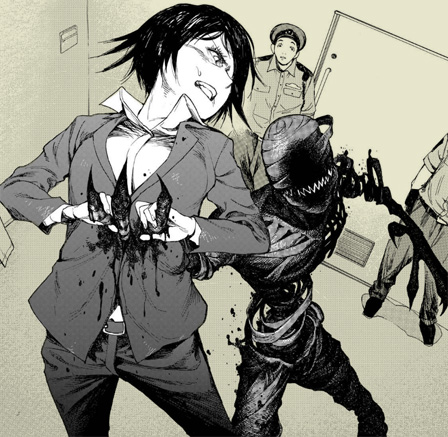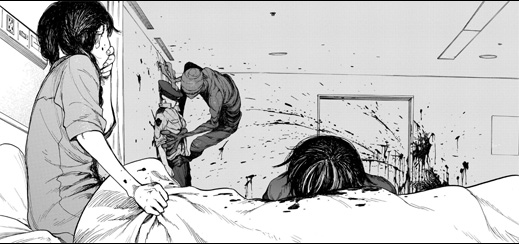Ajin: Demi-Human
Generally, my favourite sort of literature (and graphic literature) is stuff of heft and weight—reading that requires and rewards thoughtful interaction. I loved Bolaño's Savage Detectives, Julian Barnes' Sense of an Ending, Tom McCarthy's Remainder. I reward books like Duncan the Wonder Dog and Nao of Brown with high spots on my Top Comics list.

And at this point there's not really any sense bothering to ask, Do I like these kinds of books because they are the best books or do I like these kinds of books because I want to be the kind of person who likes these kinds of books? By now, it hardly matters. Whether there was any kind of pretension in my initial interest in thoughtful books, they've long since become my preferred playground in the medium. It's one of these I-yam-what-I-yam sorts of things. Irrevocable, probably.
But every now and then, I run counter to the programming and really just want something fun to occupy myself. Something light, something thrilling. Something entirely plot-driven. Something... not pregnant with meaning.
For a long time, I tied my long-waned interest in superhero books to the fact that they were ultimately low-value trifles. They were, mostly, just dumb fun books—and who has time for that when there are more solid, worthwhile graphic novels out there than any of us will ever have time to read? But I was wrong. I misplaced the origin of my distaste for superheroes. It didn't have anything to do with their plot-driven sensationalism. After all, I adore Korean dramas, don't I? The trick with Marvel's and DC's hero books is that they don't feature characters so much as they forward story-engines.11I feel I've mentioned this recently. Forgive me if I'm treading the same ground over and again. There are skips and trips in my memory, and I find it at least as frustrating as you. Where characters have arcs and growth and progression, the whole point of Spider-Man or Batman is to tell Spider-Man or Batman stories. They can never be allowed to stray from archetype because they are not characters, but product generators. That's why I couldn't stay invested. There was nothing to invest in. There're only so many times that you can read the biographies of Abraham Lincoln before you—for your own sanity probably—have to move on to other biographies, to other persons.

So what I needed then was plot-driven adventures to fill in the role of mindless summer reading, but they had to be plot-driven adventures with a beginning, middle, and end. An arc. A purpose. I had to believe the characters I would become involved with could grow, evolve, age, progenate, or even die perhaps. And not in the superhero-comics meaning of death (i.e., a temporary writing trope meant to push sales). What I was looking for and what has fit my bill lately, is something like Ajin: Demi-Human.22 Despite it having a name I can never accurately remember. Ironically, I guess, the characters in Ajin die and resurrect with much greater frequency than they would in superhero books.
Though here, that's kind of the point.

Gamon Sakurai's created a world in which a rare subsection of the populace is functionally immortal. By volume 6, the series lead has died (often gruesomely) well over a hundred times. These demis have been living largely in secret for decades, camouflaged as normal humans. Rumours of their existence flit through society, but most people are pretty sure it's all a hoax. A few volumes in, a war erupts between a group of demi-humans and the Japanese government, leaving probably few who doubt the existence of the demis.
Demi-humans, in addition to resurrecting over and over and over again, manifest a strange shadowy ghost figure that looks like some sort of clawed, oozing mummy. Each demi's manifestation is slightly different based on practice and focus. These ghosts, while invisible to non-demis, maintain very real interactions with the physical world and can kill and destroy with little trouble. There are a number of weaknesses and strange properties to the ghosts that are gradually revealed through the series, and Sakurai makes wonderful use of those fragilities.

It's a thrilling ride and I've been comparing it to the clever excitement of Death Note33Back before Near and Mello.. There's some fantastic cat-and-mouse going on here, and Sakurai keeps things fresh by coming up with new ways to utilize the same basic set of powers. I not infrequently found myself smiling at the ingenious way the creator chose to get his characters into and out of scrapes.
The pace isn't nearly so relentless as Death Note's. In the first five volumes, there are two major action set-pieces. These are pretty tremendous, but much of the series is psychological and relational in nature. So far (in six volumes), I believe this staggering of tensions has really worked in favour of the series, but we'll see if that continues to be the case. At this point, I'm pretty well along for the ride and the series would really have to drag out (like to 25+ vols) or go south pretty quickly for me to lose interest. For now, I'm just having a lot of fun.

Good Ok Bad features reviews of comics, graphic novels, manga, et cetera using a rare and auspicious three-star rating system. Point systems are notoriously fiddly, so here it's been pared down to three simple possibilities:
3 Stars = Good
2 Stars = Ok
1 Star = Bad
I am Seth T. Hahne and these are my reviews.
Browse Reviews By
Other Features
- Best Books of the Year:
- Top 50 of 2024
- Top 50 of 2023
- Top 100 of 2020-22
- Top 75 of 2019
- Top 50 of 2018
- Top 75 of 2017
- Top 75 of 2016
- Top 75 of 2015
- Top 75 of 2014
- Top 35 of 2013
- Top 25 of 2012
- Top 10 of 2011
- Popular Sections:
- All-Time Top 500
- All the Boardgames I've Played
- All the Anime Series I've Seen
- All the Animated Films I've Seen
- Top 75 by Female Creators
- Kids Recommendations
- What I Read: A Reading Log
- Other Features:
- Bookclub Study Guides










